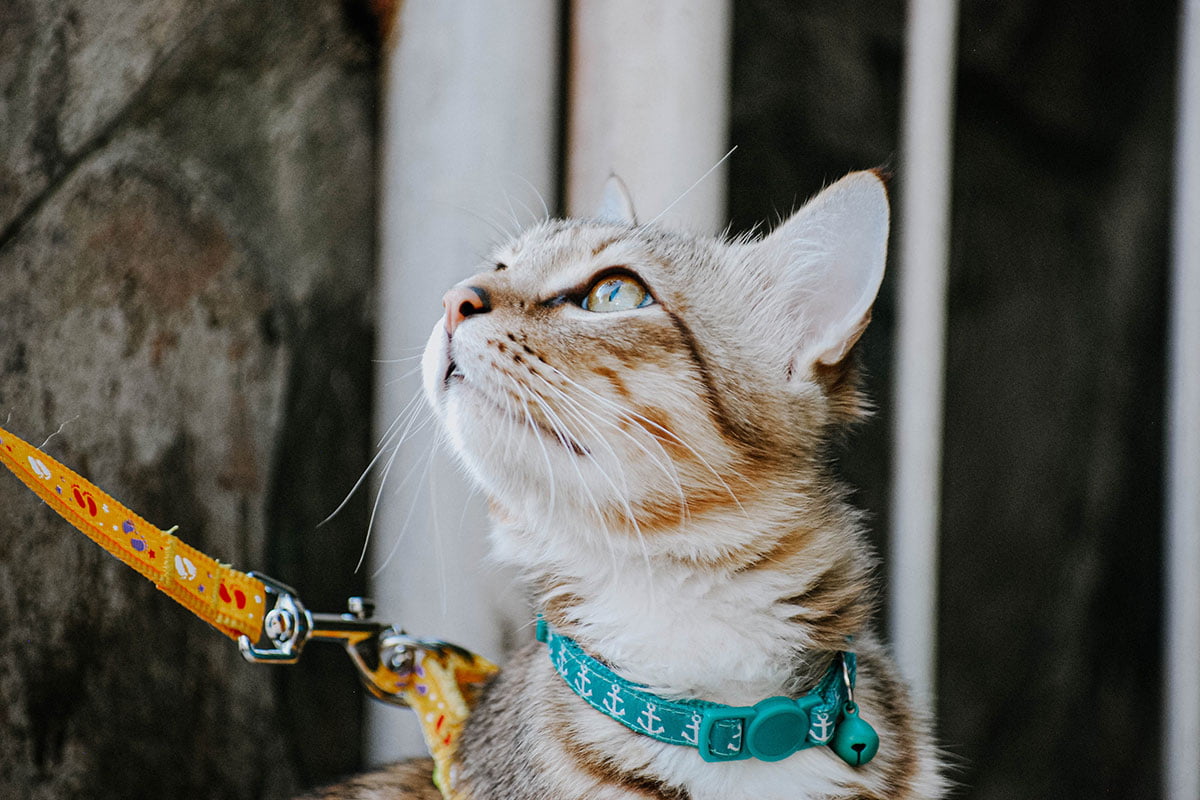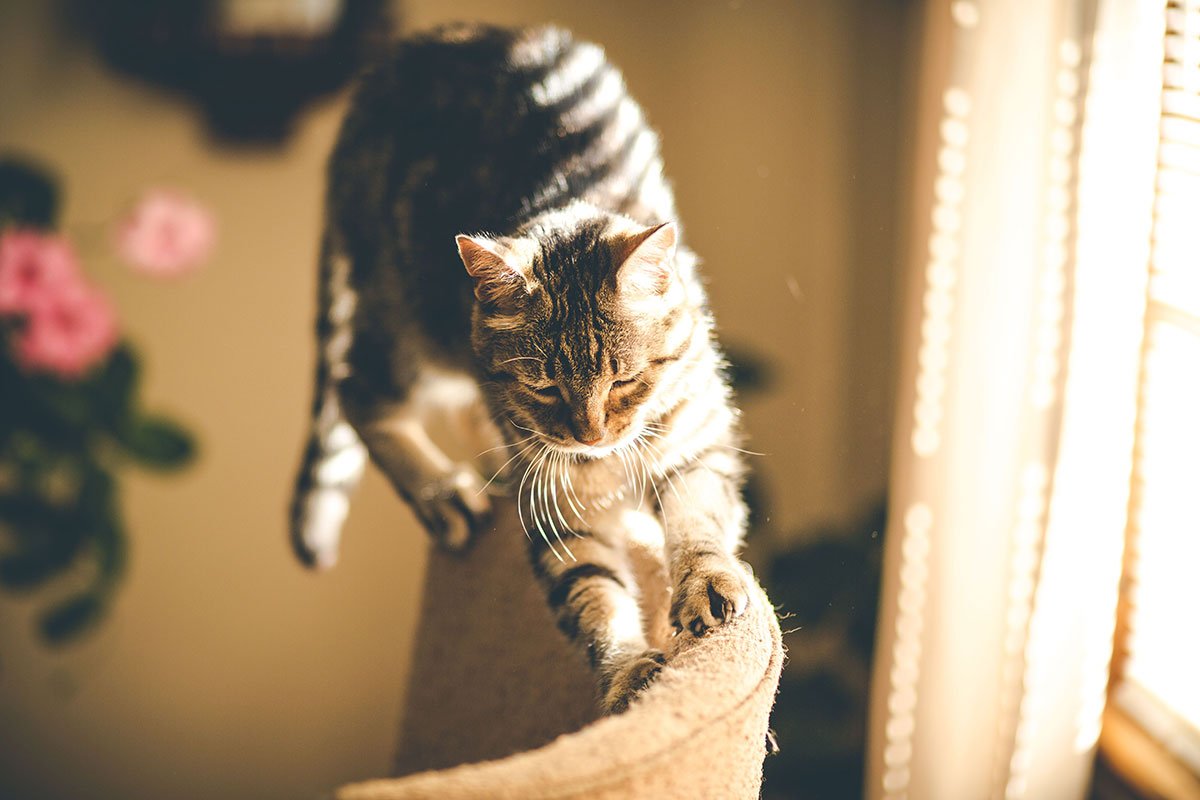Is your cat scratching your favorite chair or couch? Or perhaps you’ve just got a new cat and you want to make sure to start her off on the right foot by using a scratch post. There are also always those stubborn cats who don’t seem to want to use a scratching post no matter what you try. Either way, we’ve got you covered with some tips and tricks on training cats to use their posts, to help give you peace of mind and save your furniture. The two main aspects of scratch post training are the characteristics of the post itself, as well as positive behavioral association techniques.
What Makes a Good Post?
What to Look for in a Scratch Post
The first consideration in scratch post training is choosing the right post. What makes a post right for your cat? Here are some general rules. If you are using a vertical post, make sure it is very sturdy and won’t budge when your cat uses it. If they don’t feel safe using their post even once, chances are high that your cat won’t use it again. So, select a post that you can either secure to the floor or is heavy enough on its own to stand solid no matter how your cat chooses to use it.
Another important consideration for vertical posts is height. One reason that cats enjoy scratching is to stretch their spines, which is why you often see cats scratching while they are standing up on their back legs, with their front paws raised above their head. As a result, make sure the post you select is more than tall enough to let your cat stretch out without reaching the top. Some cats may prefer horizontal posts, in which case height isn’t as crucial, but sturdiness is still essential.
What Kind of Material Should I Use?
Keep in mind that you also have different material options when selecting a scratching post. Carpet, although historically popular, may not be the best choice because claws can get stuck in the loops, which your cat might not enjoy and cause her to stop using it. Instead, consider sisal rope, old upholstery fabric, cardboard or wood. Don’t be afraid to test out a few options to see what your cat prefers.
Giving Your Cat Options
In addition, consider getting more than one post for your furry friend to enjoy, especially if you have more than one cat. Another reason why cats naturally scratch is to mark their territory visually and with their scent (cats have scent glands in their paws). So, you can’t expect that two cats will use the same post, when one cat has claimed the post, the other will likely pick something else like a piece of furniture. Even if you have just one cat, giving her options means it’s more likely that she’ll stay away from furniture.
Where to Put Your Cat’s Post
Last but certainly not least, remember that placement matters. Ideal placement for ensuring your cat will use her post is in prominent areas in your home, not tucked away in the basement or in a corner. Although it may not be convenient to us or match up with our ideas about interior design, recall that part of the reason why cats like to scratch is to make their territorial presence known. As a result, your favorite chair in the centre of the living room might look more appealing than a scratch post that is in the back corner.
Additionally, take a look at where and what your cat is scratching now. If they are using a piece of furniture and you want to discourage this, you can put a post near that furniture, and use some of the behavioral techniques discussed below to help them make the switch. You can also cover furniture with a tucked in blanket or thick sheet, move it to a different spot, and/or put double sided sticky tape on some of the spots where your cat is scratching (cats typically don’t like to touch sticky surfaces).
Cats also often like to scratch after waking up from a nap to stretch out and get a little exercise, so consider putting a post near their favorite sleeping area. If your cat likes to look outside, you might consider putting a post near their favorite window, as watching the action outdoors might get them excited and get them scratching.
Encouraging Your Cat to Use Their Post
What can you do as a cat parent to encourage your cat to scratch in the right places? What training methods can you employ? The name of the game is positive association. In a nutshell, we want to entice our cats to use their posts by making their experience enjoyable and rewarding them for good behavior afterward. Ideally, we want to be training them with positive association from a very early age. Starting training young has the benefit of having more time on our side, not having to try to ‘unlearn’ any ingrained but undesirable behaviors, and guiding them at a time when they might be more willing to listen.
Making a Post More Appealing
There are a couple tools we can use to make using a scratch post more fun for our cats. The first is catnip. If your cat enjoys it, you can sprinkle small amounts at the base and top of the scratching post. Your cat might knead her claws after eating or smelling the catnip, which will show her that the post is a perfect surface for scratching. You can also substitute catnip for treats if your cat prefers the latter, and can even encourage her to stretch up towards the top of the post before giving them to her.
Another way to make the post look appealing is through play. Using a toy that encourages your cat to reach high up the post might get her excited and in the perfect position for scratching. You can also put some of her favorite toys at the top of the post to inspire her to climb up and get them. Doing that consistently for several days can help solidify the positive connection between the post, scratching and enjoying play time.
If you’ve just bought a new post and your cat seems indifferent, consider changing the angle of the post or lying it on its side. Cats, just like us, are creatures of habit. So if they are used to scratching something that has a horizontal orientation, like the top of a sofa for example, then it might help to buy a horizontal post or tip your vertical post on its side.
Using scent products can also encourage your cat to use their post. Some synthetic feline pheromone products can be sprayed directly onto a scratching post, which will help amplify her scent, making her feel more comfortable and ‘at home’ in her own territory. Remember, cats spread their scent with glands in their front paws.
Rewarding Good Behavior
Finally, make sure to praise your cat when you see that they are using their post. This can include giving treats, petting or talking to them in a soothing voice. Whatever your cat likes, you want to build that connection in their mind between using the post and a positive outcome, which will encourage them to use it more in the future.
What to Avoid in Scratch Post Training
There are also a few pitfalls to avoid when scratch post training your cat. In general, avoid negative training methods wherever possible. Scratching is a common, natural behavior for cats, and yelling at them when they do so might stress and confuse them. They will associate you catching them scratching with a negative outcome, which might cause them to hide from you and simply scratch at other times.

Physically placing your cats paws on their post is probably best avoided as well, unless you are sure your cat is very easy going and won’t mind. The idea would be to help spread your cat’s scent onto the post and show what is okay to scratch. However, cats typically like to come to conclusions on their own, and forcing your cat to do something they may initially be uneasy about could cause them to shun the post altogether. Be sure to not throw out their favorite scratch post at the first sign of wear and tear. The point that a post has become well used is also the point that your cat’s habits, comfort and territory are most established.
What’s more, posts that have become torn up or shredded are easier for cats to dig their nails into. If you’ve made up your mind about a change, it may be wise to introduce a new post and get your kitty using it before throwing out an old one.
Top Selling Scratch Posts on Amazon
[amazon bestseller=”Cat Scratch Post”]



